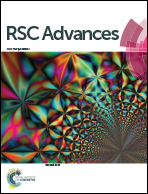Design of an ultra-sensitive gold nanorod colorimetric sensor and its application based on formaldehyde reducing Ag+†
Abstract
Formaldehyde (HCHO) could reduce Ag+ to Ag on the surface of gold nanorods (AuNRs) to form Au core–Ag shell nanorods (Au@AgNRs) in a AuNRs–Ag+–HCHO system, which caused the dielectric function to change, the longitudinal plasmon absorption band (LPAB) of AuNRs to redshift (ΔλLPAB) and the color of the solution to change obviously. Thus, a responsive, simple, sensitive and selective AuNRs colorimetric sensor for the determination of HCHO has been developed based on the linear relationship between ΔλLPAB and the concentration of HCHO. The limit of detection (LOD) of this sensor is 6.3 × 10−11 (g mL−1), which is much lower than that of surface-enhanced Raman spectroscopy (SERS), showing its high sensitivity. What's more, the sensor has been applied to the detection of HCHO in water samples with the results agreeing well with resonance fluorescence spectrometry, showing its great practicality. Furthermore, the morphological changes of AuNRs and Au@AgNRs were characterized by transmission electron microscopy (TEM) and the sensing mechanism for the detection of HCHO was also discussed.


 Please wait while we load your content...
Please wait while we load your content...